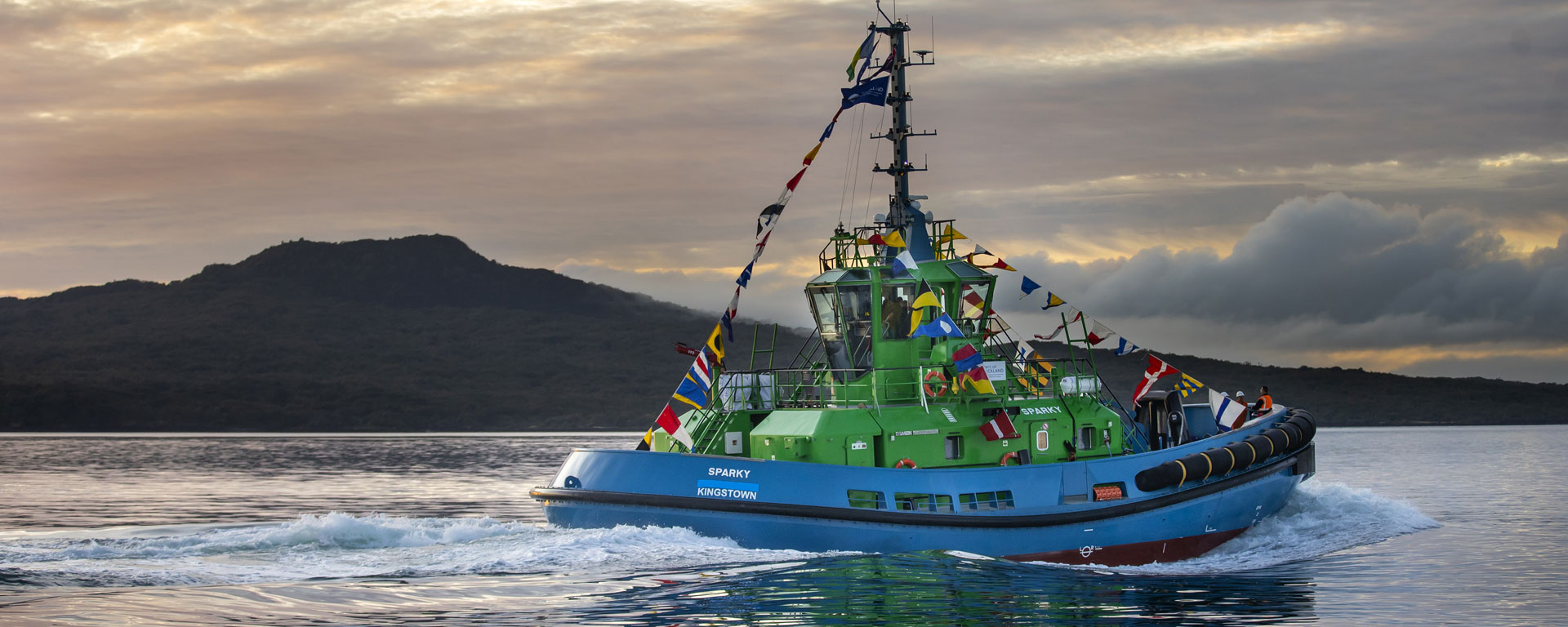The fleet of electric tugs is growing around the world under pressure from ports and the public. Transport journalist Selwyn Parker jumps on board to report on the new vessels that are greening our ports.
Until a few short years ago, the electrically powered harbour tug was pretty much a vision, albeit one embraced by environmentally conscious ports, far-sighted naval architects and residents living near busy harbours seeking a quieter life.
Then it all changed with the arrival of two diesel-free, battery-driven tugs capable of fulfilling their duties in almost complete silence and pollution-free. The first of these pioneering vessels, arriving in late 2022, was Sparky, the result of a six-year collaboration with the Damen shipyard in Vietnam and the owner, Ports of Auckland in New Zealand that has pledged to be entirely emission-free by 2040.
The second, HaiSea Wamis, was built by the Sanmar Shipyards in Türkiye and delivered to owner Seaspan in mid-2023. Its job is to escort and tow liquefied natural gas (LNG) carriers at Kitimat in British Columbia, a highly environmentally conscious region.
Quite suddenly, a fleet of electrically powered tugs is emerging around the world. Seaspan now has two sister tugs to HaiSea, technically known as ElectRA 2800 (the RA standing for Vancouver-based designer Robert Allan). The Port of Antwerp-Bruges has ordered one, a first for northern Europe, and Istanbul’s Port of Gisas now boasts two battery-driven tugs.
And in the Californian spring the Port of San Diego will welcome eWolf, the first American-built, battery-driven tug to operate in the US. Out of the Alabama yard of Master Boat Builders, the 25 metre-long eWolf is, according to veteran American shipping journalist John Snyder, “a step change in harbour tug technology because it will operate without fossil fuels and traditional diesel mechanical propulsion.”
Like its predecessors, there’s little that eWolf cannot do compared with traditional diesel-fuelled tugs. “It offers full performance capabilities of a conventional tug”, explains Crowley, the operating company. In technical terms the tug has a bollard pull (a proxy for power) of 70 tonnes, quite enough to berth the biggest vessels.
And also like Sparky and Seaspan’s tugs, the creation of eWolf was a collaborative affair, in this case under the umbrella of the California Air Resources Board that helped harness various environmental agencies and the port itself, which has a zero-emission remit. While eWolf is helping clean up the air around the harbour, the port is running a long-term decarbonisation programme that includes electric cranes, trucks and other currently diesel-fuelled infrastructure.
One of the centrepieces of the programme is shoreside charging, a technology that has gone ahead in leaps and bounds in the last few years. The eWolf will be plugged into its own partly solar-powered microgrid rather than sucking power off the local community’s grid.
If electric tugs can match conventional tugs, why aren’t there more of them? One issue is cost. Silent, clean sailing comes at a price. Typically, electric tugs cost roughly 50 per cent more than an equivalent diesel-fuelled design, according to their builders. The precise speed of payback is not yet known, but the savings in fuel are obviously 100 per cent and electric tugs require much less maintenance.
According to Damen, the builders of Sparky, the batteries, which have an energy storage capacity of 2 800 kilowatt hours, are built to last at least as long as the tug. “The lifetime of the battery is expected to be approximately 30 000 cycles, which is equal to more than the 30-year lifetime of our tugs.”
An interim solution is hybrid-powered tugs that combine diesel with batteries. According to battery supplier Corvus, they can run longer than pure electric vessels, up to several hours, and can, therefore, operate in the inner harbour and the open sea. By contrast, Sparky has to be recharged after two assignments.
“Hybrid-powered tugs typically reduce fuel consumption and emissions by 30 to 60 per cent compared to traditional, diesel-powered tugboats,” Corvus explains, also citing less wear and tear on the engine.
It’s unlikely, though, that diesel-fuelled tugs will become obsolete for some years. For instance, powerful new ones have been ordered to push heavy barges up the Amazon on voyages that take days at a time. Authorities like the chief executive of tug-designer Robert Allan, Mike Fitzpatrick, believes the solution for this kind of operation will be greener fuels, at least until battery technology “increases by an order of magnitude”.
But provided they can be given longer-lasting power, pure electric tugs remain the environmentalist’s holy grail. Over its first ten years of operation, the Port of San Diego’s new tug will give off 2.5 tonnes less diesel particulate, 178 less tonnes of nitrogen oxide and around 3 000 tonnes less carbon dioxide than if it were diesel-fuelled.
Looking ahead, Mike Fitzpatrick tells Transport Policy Matters “there are no technical reasons why a battery electric tug cannot be built with a bollard pull of 80-plus tonnes” if that’s what the customer wants. It’s all a question of optimising the propulsion arrangement and battery bank size for a particular operation.
But there’s little doubt that the worldwide fleet of electric tugs is set to grow at the expense of conventional alternatives. And given the rapid development of battery power, that could happen faster than many think.
Selwyn Parker is an independent journalist and author of Chasing the Chimney Sweep about the first Tour de France of 1903.
The International Transport Forum’s work towards sustainable maritime transport includes studies on electrification, alternative fuels, carbon pricing and efficiency gains to bridge the gap between increasing demand and rising emissions. Learn more
Related publications:
Decarbonisation, Coastal Shipping and Multimodal Transport
